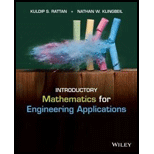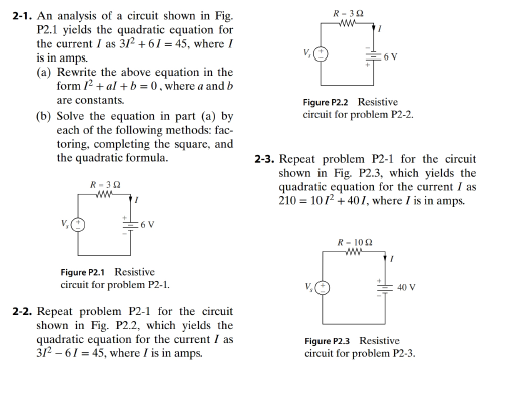
An analysis of a circuit shown in Fig. P2.1 yields the
(a) Rewrite the above equation in the form
(b) Solve the equation in part (a) by each of the following methods: factoring, compacting the square, and the quadratic formula.

(a)
To rewrite the given current relation in the form of
Answer to Problem 1P
The required equation of current in the form of
Explanation of Solution
Given:
The current relation is given as
Calculation:
Divide by
Rearrange above equation.
The required equation of current in the form of
Conclusion:
Thus, the required equation of current in the form of
(b)
Solve the equation
Answer to Problem 1P
The equation is solved by factoring, completing the square, and the quadratic and the roots of the equation are
Explanation of Solution
Concept Used:
The roots of the quadratic equation can be determined by the quadratic formula given as-
Calculation:
Substitute
This equation gives two values of current
For completing square method,
Rearrange equation (1)
Add
Rearrange the above equation.
The value of current
For factoring method,
Rearrange equation (1)
The value of current
Want to see more full solutions like this?
Chapter 2 Solutions
Introductory Mathematics for Engineering Applications
Additional Math Textbook Solutions
A First Course in Probability (10th Edition)
Basic Business Statistics, Student Value Edition
Algebra and Trigonometry (6th Edition)
Probability And Statistical Inference (10th Edition)
Intro Stats, Books a la Carte Edition (5th Edition)
- Find the area bounded by f(x) = sin x, g(x) = cos x in the first quadrant.arrow_forward1. Matrix Operations Given: A = [ 33 ]A-[3-321] -3 B = [342]B-[3-41-2] (a) A² A2 Multiply A× A: -3 = (3 x 32x-3) (3 x 22 x 1) | = |[19–63 |-9-3 -6+21] = A² = 33 33 1-3×3+1x-3) (-3×2+1x1) [12]A2=[3-321][3-321]=[(3×3+2x-3)(-3×3+1x-3)(3×2+2×1)(-3×2+1×1)]=[9-6-9-36+2-6+1 ]=[3-128-5] (b) | A ||A| Determinant of A | A | (3 × 1) (2 x-3)=3+ 6 = 9|A|=(3×1)-(2x-3)=3+6=9 (c) Adjoint of A Swap diagonal elements and change sign of off-diagonals: A = [33], so adj (A) = |¯²]A=[3-321], so adj(A)=[13–23] -3 (d) B-¹B-1 First find | B ||B|: |B | (3x-2)- (1 × -4) = -6 + 4 = −2|B|=(3x-2)-(1x-4)=-6+4=-2 Then the adjoint of B: adj (B) = [² 3 adj(B)=[-24-13] Now, B-1 1 = |B| · adj (B) = 1 [²¯¯³¹³] = [2₂ B 0.5 |B-1=|B|1-adj(B)=-21[-24-13]=[1-20.5-1.5] 2. (a) Matrix Method: Solve (2x + 3y = 6 (2x-3y=14 {2x+3y=62x-3y=14 Matrix form: 22 33-22 = [223-3][xy]=[614] Find inverse of coefficient matrix: Determinant: | M | (2x-3) - (3 x 2) = -6 -6 = -12|M|=(2x-3)-(3×2)=-6-6=-12 Adjoint: adj(M) = [3]adj(M)-[-3-2-32] So…arrow_forwardQuestions An insurance company's cumulative incurred claims for the last 5 accident years are given in the following table: Development Year Accident Year 0 2018 1 2 3 4 245 267 274 289 292 2019 255 276 288 294 2020 265 283 292 2021 263 278 2022 271 It can be assumed that claims are fully run off after 4 years. The premiums received for each year are: Accident Year Premium 2018 306 2019 312 2020 318 2021 326 2022 330 You do not need to make any allowance for inflation. 1. (a) Calculate the reserve at the end of 2022 using the basic chain ladder method. (b) Calculate the reserve at the end of 2022 using the Bornhuetter-Ferguson method. 2. Comment on the differences in the reserves produced by the methods in Part 1.arrow_forward
- The numbered disks shown are placed in a box and one disk is selected at random. Find the probability of selecting a 4, given that a green disk is selected. Find the probability of selecting a 4, given that a green disk is selected. (Type an integer or a simplified fraction.) green blue green green green blue green bluearrow_forwardThe table shows the distribution, by age, of a random sample of 3160 moviegoers ages 12-74. If one moviegoer is randomly selected from this population, find the probability, expressed as a simplified fraction, that the moviegoer is not in the 65-74 age range. The probability is (Type an integer or a simplified fraction.) Age Distribution of Moviegoers Ages Number 12-24 1090 25-44 860 45-64 890 65-74 320arrow_forwardUse the spinner shown. It is equally probable that the pointer will land on any one of the six regions. If the pointer lands on a borderline, spin again. If the pointer is spun twice, find the probability that it will land on yellow and then yellow. Find the probability that the spinner will land on yellow and then yellow. The probability is (Type an integer or a simplified fraction.) Green Red Gray Red Blue Yellow Q ☑arrow_forward
- Use the spinner shown to answer the question. Assume that it is equally probable that the pointer will land on any one of the colored regions. If the pointer lands on a borderline, spin again. If the spinner is spun once, find the probability that the pointer lands in a region that is red or green. The probability that the pointer lands in a region that is red or green is (Type an integer or a simplified fraction.) green red green red yellow redarrow_forwardLet $f(x)$ be a continuous function on the interval $[0,1]$ such that $f(0) = f(1) = 0$. Prove that for any positive integer $n$, there exists a real number $x$ in $[0, 1 - \frac{1}{n}]$ such that $f(x) = f(x + \frac{1}{n})$.arrow_forwardK/FT イ 5 SLOPE AB TB3.3 C 15 TROY 16.7 y Yo 13.3 GIVEN: BEAM + LOADING DRAW V+H SOLUTION: DIAGRAMS 1) FIND REACTIONS R=14/15 (20) = 20k (@EMB=20F (5) - Roy(15) RRY = 6.7k EFу=0= 20+67+RBY RBY = 13.3k+ 5 6.7 roarrow_forward
- Algebra & Trigonometry with Analytic GeometryAlgebraISBN:9781133382119Author:SwokowskiPublisher:Cengage
 Elements Of Modern AlgebraAlgebraISBN:9781285463230Author:Gilbert, Linda, JimmiePublisher:Cengage Learning,
Elements Of Modern AlgebraAlgebraISBN:9781285463230Author:Gilbert, Linda, JimmiePublisher:Cengage Learning, College Algebra (MindTap Course List)AlgebraISBN:9781305652231Author:R. David Gustafson, Jeff HughesPublisher:Cengage Learning
College Algebra (MindTap Course List)AlgebraISBN:9781305652231Author:R. David Gustafson, Jeff HughesPublisher:Cengage Learning  Elementary Linear Algebra (MindTap Course List)AlgebraISBN:9781305658004Author:Ron LarsonPublisher:Cengage Learning
Elementary Linear Algebra (MindTap Course List)AlgebraISBN:9781305658004Author:Ron LarsonPublisher:Cengage Learning Algebra: Structure And Method, Book 1AlgebraISBN:9780395977224Author:Richard G. Brown, Mary P. Dolciani, Robert H. Sorgenfrey, William L. ColePublisher:McDougal Littell
Algebra: Structure And Method, Book 1AlgebraISBN:9780395977224Author:Richard G. Brown, Mary P. Dolciani, Robert H. Sorgenfrey, William L. ColePublisher:McDougal Littell




